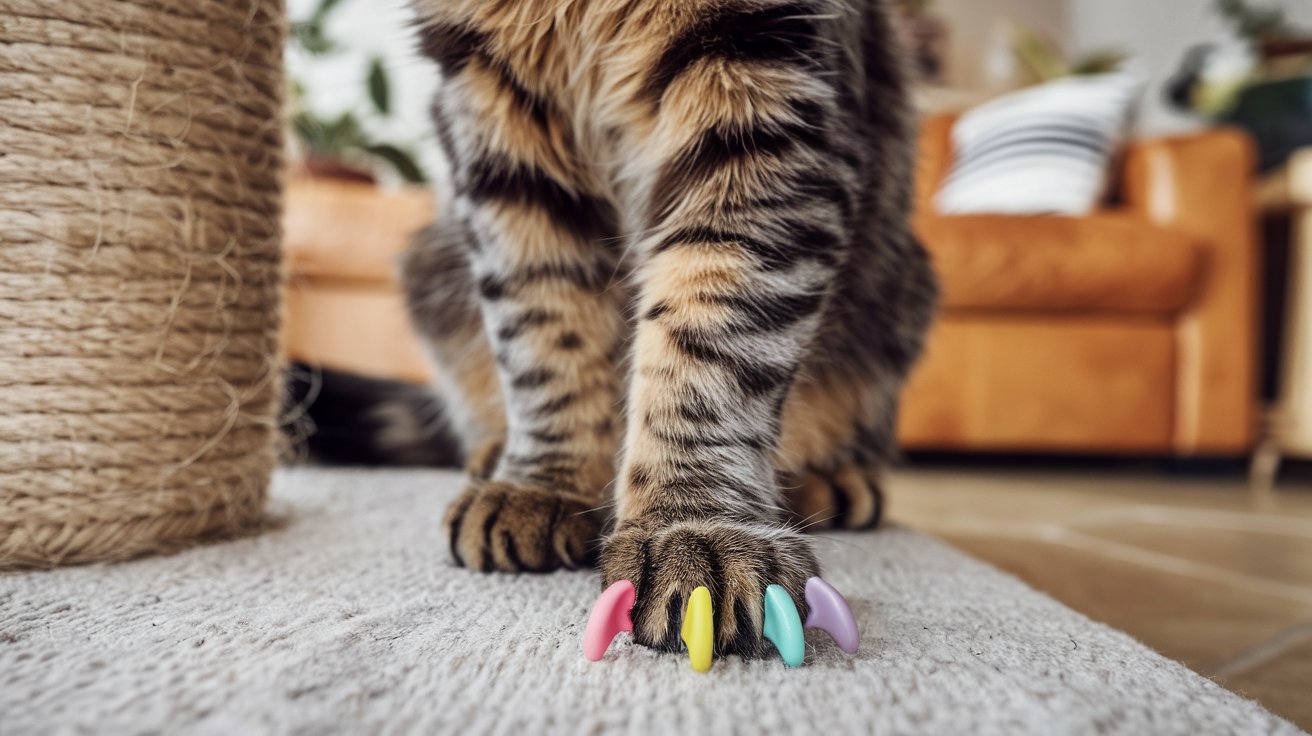Overview
“Do claw caps hurt cats?” is a question that many pet owners frequently have, especially when they’re trying to find ways to stop their animals from clawing people or damaging furniture. Claw caps, also known as soft nail caps, are small vinyl coverings that can be glued onto a cat’s claws. They are designed to reduce the impact of a cat’s natural scratching behavior without causing harm.
Pet owners consider using claw caps as an alternative to declawing, which is a much more invasive procedure. Claw caps are gentle and non-permanent, making them a popular choice for those who want to protect their furniture and reduce accidental scratches while ensuring their cat’s comfort.
What Are Claw Caps?
Claw caps are small, soft vinyl covers that are gently glued onto a cat’s claws. These caps are designed to dull the sharpness of a cat’s nails without interfering with their natural movement. The material is flexible and lightweight, so once applied, most cats quickly adapt to them without discomfort. The application process involves trimming the cat’s nails, applying a safe adhesive inside the cap, and gently sliding it over each claw. The entire procedure is simple and quick, and a veterinarian or homeowner can complete it.
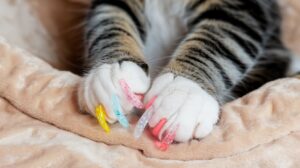
Claw caps come in a variety of colors, including clear, bright shades, and even glittery options, allowing pet owners to choose based on their preferences. Some brands offer different sizes to accommodate cats of all ages, from kittens to adult cats. In terms of longevity, claw caps typically last around 4 to 6 weeks before they naturally fall off as the cat’s claws grow. Once they fall off, they can easily be reapplied, ensuring continuous protection.
Reasons for Using Claw Caps
One of the primary reasons pet owners turn to claw caps is to protect furniture and household items from damage. Cats have a natural instinct to scratch, and this can often result in torn sofas, scratched tables, and shredded curtains. Claw caps provide a protective barrier, reducing the wear and tear caused by scratching without inhibiting the cat’s normal behaviors.
Claw caps also help prevent injuries to people and other pets. Cats sometimes scratch unintentionally during play or when startled, which can lead to painful cuts. For households with children or other animals, claw caps offer an extra layer of safety, ensuring that interactions with the cat remain gentle and harm-free.
Additionally, claw caps are useful for managing aggressive or overactive scratching behavior. Some cats are more energetic or anxious, leading to excessive scratching. While training and behavioral modification techniques are essential, claw caps serve as a temporary solution to curb destructive habits, allowing owners to manage scratching while working on long-term solutions.
Do Claw Caps Hurt Cats?
When applied correctly, claw caps do not hurt cats and cause minimal physical discomfort. The process itself is non-invasive and painless, though some cats may take time to get used to the feeling of having the caps on their claws. During the initial application, cats might show slight discomfort, much like they would after having their nails trimmed. However, once the caps are in place, most cats go about their daily activities without showing any signs of pain or irritation.
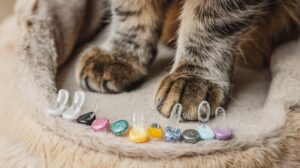
In terms of impact on a cat’s natural behavior, claw caps may alter the effectiveness of scratching, but they don’t stop the action itself. Cats can still stretch, scratch, and climb, although their claws won’t be able to cause damage. Some owners may worry that the caps could restrict their cat’s movement, but cats generally adapt quickly. They can still extend and retract their claws without any difficulty, allowing them to perform most of their usual activities, such as walking or gripping surfaces.
Veterinarians generally agree that claw caps are a safe and humane option compared to declawing, which is a more drastic and painful procedure.Claw caps are safe to use as long as they are put on properly. However, there are risks if the caps are applied improperly. Improper fitting or application can lead to complications, such as discomfort, infection, or restricted movement. It is essential to follow the application instructions carefully and monitor the cat’s claws for signs of irritation or swelling. If any issues arise, it’s important to remove the caps immediately and consult a veterinarian.
Alternatives to Claw Caps
While claw caps are a popular option, there are several alternatives for managing a cat’s scratching behavior. One simple and effective method is regular nail trimming. By keeping a cat’s nails short and blunt, the damage they cause when scratching is significantly reduced. Trimming is painless when done properly, although some cats may need time to adjust to the process. Regular trims performed every few weeks, can help maintain their claws without the need for caps.
Providing scratching posts and pads is another highly recommended option. These items offer cats designated areas to scratch, encouraging them to leave furniture and other household items alone. Cats naturally enjoy scratching different textures and investing in high-quality, stable scratching surfaces can redirect their energy and satisfy this instinct. It’s important to place the posts in areas where the cat typically scratches to increase the likelihood they’ll use them.
Behavior training is also a valuable approach, teaching cats where and when scratching is appropriate. Positive reinforcement, such as treats and praise, can be used to reward a cat for using designated scratching areas. Training may take time and patience but can be an effective long-term solution for managing scratching.
Other humane alternatives include tools like nail grinders, which can smooth out sharp claws, and pheromone sprays, which help reduce anxiety-driven scratching by calming the cat. Each of these methods provides a safe way to manage scratching while preserving the well-being of the cat.
Are Claw Caps Safe?
Claw caps are generally safe for cats when used correctly, but there are important safety considerations to keep in mind. Ensuring a proper fit is crucial to avoid discomfort or potential complications. Claw caps come in various sizes, so selecting the right size for your cat’s claws is essential. Caps that are too tight can cause irritation, while those that are too loose might fall off prematurely. Monitoring your cat’s behavior after application is also important; any signs of persistent discomfort, swelling, or difficulty moving should be addressed promptly.
To ensure safety, applying claw caps correctly is key. Here is a complete instructions for the proper application:
Prepare Your Supplies: Gather the claw caps, a safe adhesive (usually provided with the caps), and any tools you might need for nail trimming.
Trim the Cat’s Nails: Gently trim the cat’s nails to avoid any interference with the claw cap’s fit. The quick is the area of the nail that is sensitive, so take care not to cut it too near.
Apply the Adhesive: Place a small amount of adhesive inside each claw cap. Make sure to use an adhesive that is specifically designed for claw caps, as it is safe for pets.
Fit the Claw Caps: Carefully slide each claw cap over the cat’s trimmed nail. Ensure it covers the nail completely and is snug but not too tight.
Monitor the Application: After application, observe your cat for a few hours to ensure they are adjusting well to the claw caps. Look for any signs of discomfort or irritation and ensure that the caps stay securely in place.
By following these steps and keeping an eye on your cat’s well-being, you can ensure that claw caps are a safe and effective option for managing scratching behavior.
Claw Caps vs. Declawing
When comparing claw caps to declawing, it’s important to recognize the significant differences in their approach and impact on a cat’s well-being. Claw caps are a non-invasive, humane solution designed to reduce the damage caused by a cat’s claws. They simply cover the claws, preventing them from causing harm to furniture or people while still allowing the cat to use its claws naturally for scratching and climbing. The application of claw caps is a straightforward process that can be done at home or by a veterinarian, and the caps can be easily replaced as needed.

Declawing, on the other hand, is a far more invasive surgery in which a cat’s claws and occasionally a portion of the bone to which they are linked are surgically removed. This procedure is often compared to amputating a human finger at the last joint. Declawing can lead to significant ethical and health concerns. Ethically, many animal welfare organizations view declawing as a form of mutilation that is unnecessary for the well-being of the cat. Health-wise, the procedure can cause pain, long-term physical issues such as lameness or behavioral changes, and difficulties with balance and mobility.
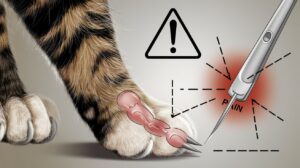
In contrast to declawing, claw caps offer a temporary and non-invasive way to manage scratching without compromising the cat’s natural abilities or causing long-term harm. They provide a compassionate alternative for pet owners seeking to protect their homes while respecting their cat’s natural instincts.
Pros and Cons of Claw Caps
Claw caps offer several advantages, but they also come with some potential drawbacks.
Pros
Non-Invasive: Claw caps are a non-invasive solution for managing scratching behavior. Unlike declawing, which is a surgical procedure, claw caps simply cover the nails with a soft, vinyl cap. This makes them a more humane and less traumatic option for both the cat and the owner.
Temporary Solution: Claw caps are designed to be a temporary solution, typically lasting 4 to 6 weeks before they need to be replaced. This allows pet owners to address scratching issues without committing to a permanent change, and it gives cats the flexibility to adjust to different situations.
Protects Furniture: One of the main benefits of claw caps is their ability to protect furniture and other household items from damage. By reducing the sharpness of a cat’s claws, claw caps minimize the risk of scratches and tears, helping to keep your home looking its best.
Cons
Possible Discomfort: Although generally well-tolerated, some cats may experience mild discomfort when claw caps are first applied. It can take a short period for them to get used to the feeling of having caps on their claws. Monitoring and adjusting the application as needed can help minimize any discomfort.
Restriction of Natural Scratching Behavior: While claw caps do not stop scratching entirely, they do dull the effect. This might impact a cat’s natural scratching behavior, which is important for their physical and emotional well-being. Cats use scratching to stretch their muscles and mark their territory, so it’s important to ensure they still have appropriate outlets for these behaviors.
Risk of Improper Application: Claw caps must be applied correctly to be effective and comfortable. Improper application can lead to issues such as caps falling off prematurely, potential infections if the adhesive is not used correctly, or restricted movement if the caps are too tight. It’s important to pay close attention to the application instructions and keep an eye out for any indications of difficulties with your cat.
Overall, while claw caps provide a practical and humane way to manage scratching, it is important to weigh these pros and cons to determine if they are the right choice for you and your cat.
Conclusion
In summary, claw caps are generally considered a safe and non-invasive option for managing a cat’s scratching behavior. When applied correctly, they do not hurt cats and can effectively protect furniture and reduce scratching incidents. Most cats adapt to the caps without significant discomfort, although there may be a brief adjustment period.
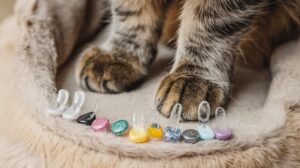
However, it’s important to consult with a veterinarian before deciding to use claw caps. A vet can provide guidance on the appropriate size and application method, and address any specific concerns related to your cat’s health and behavior. Your vet can also help you evaluate whether claw caps are the best solution for your situation or if other alternatives might be more suitable. By working with a professional, you can ensure that your approach to managing scratching is both effective and compassionate for your feline friend.
